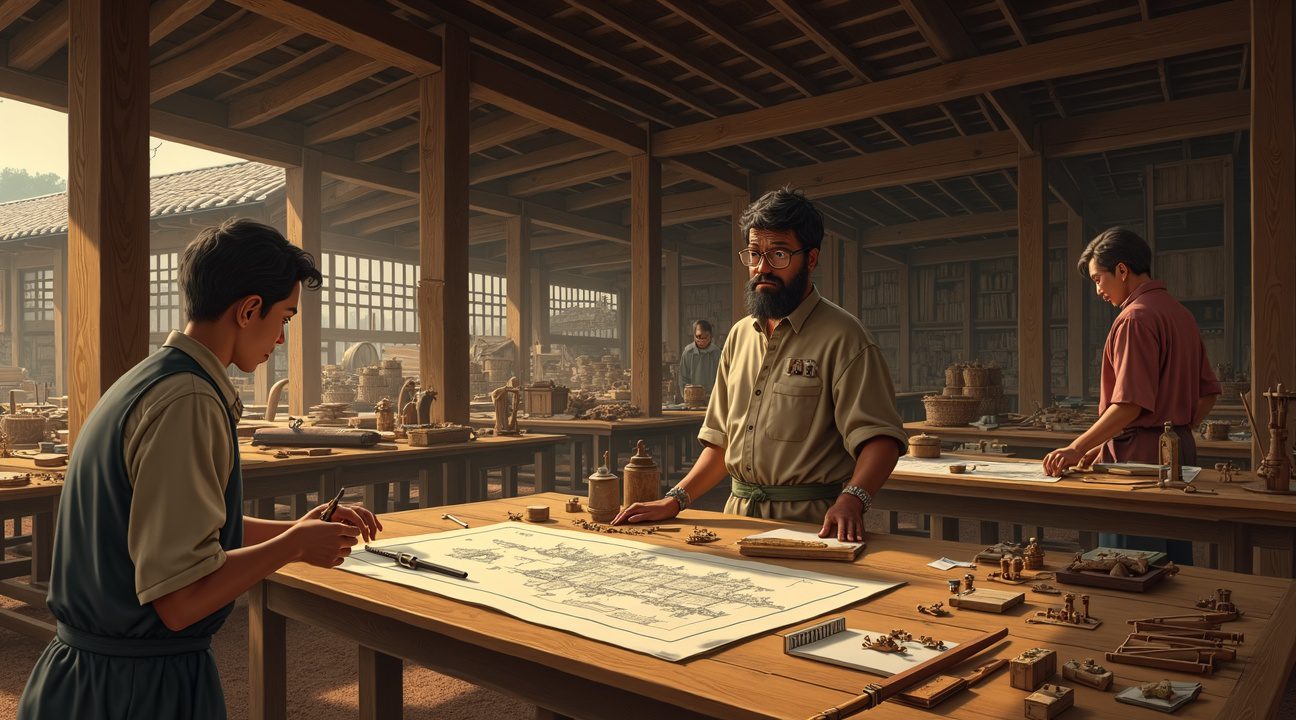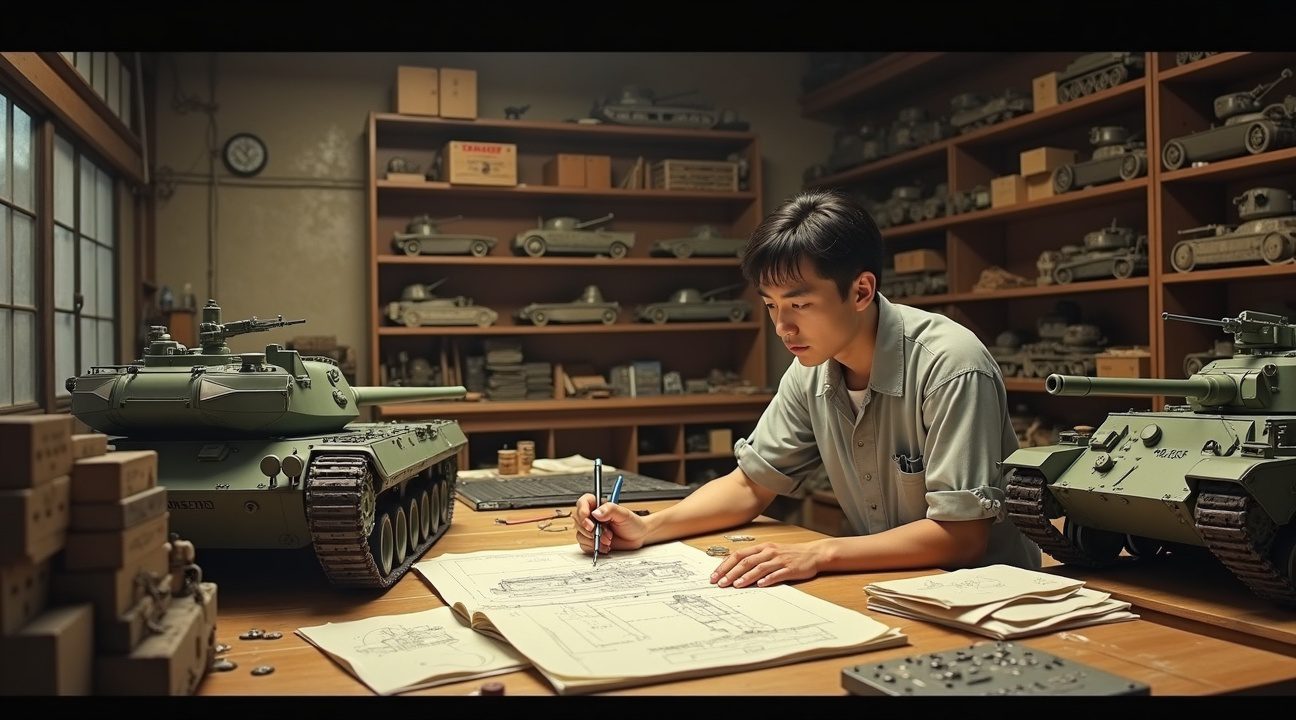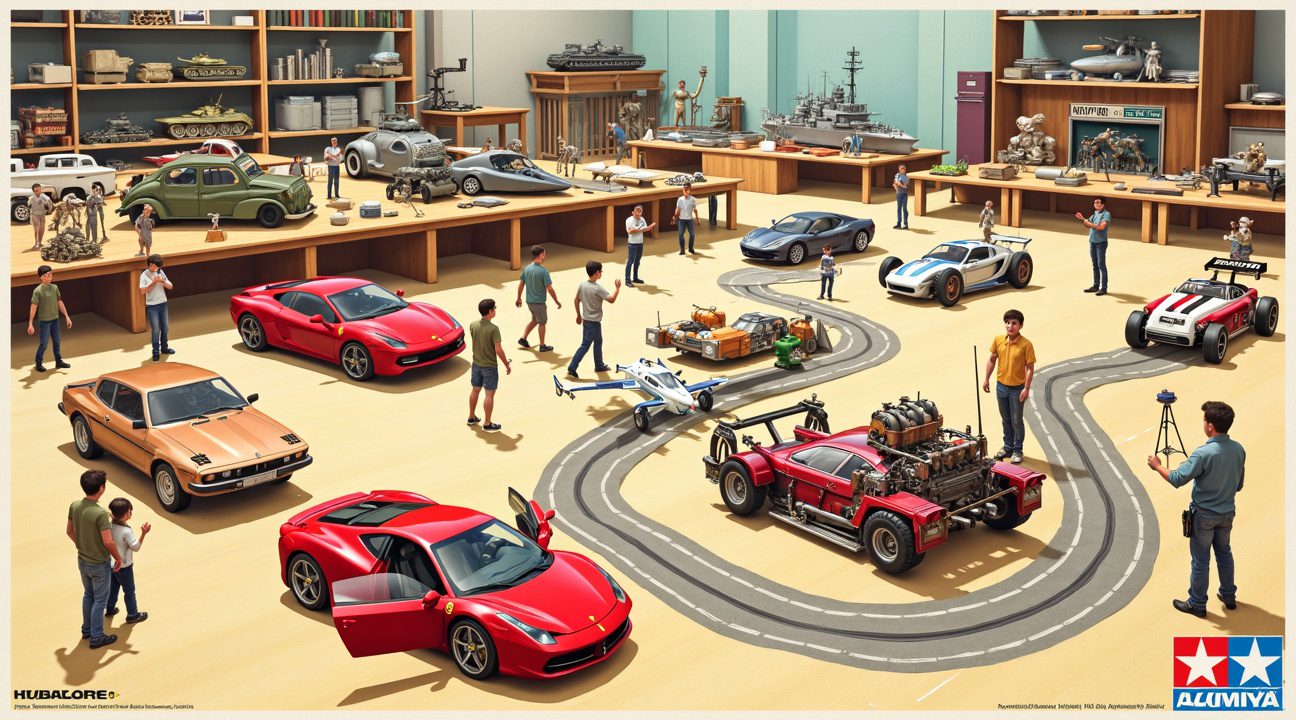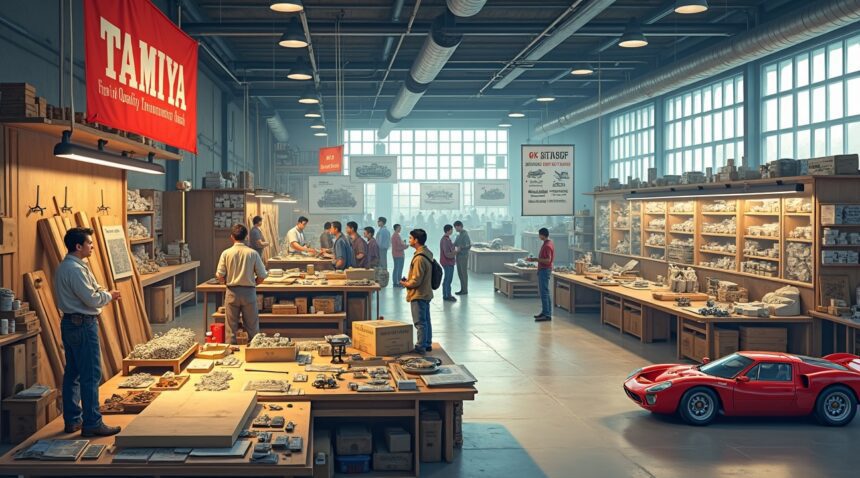Tamiya Corporation’s transformation from a post-war sawmill operation to the world’s premier model kit manufacturer represents one of the most remarkable business changes in Japanese industrial history.
Founded by Yoshio Tamiya in 1946, the company made the bold decision to abandon lumber production entirely by 1953 to focus on wooden model kits. This strategic pivot laid the groundwork for a series of innovations—ranging from plastic model kits to radio-controlled (RC) vehicles—that would redefine the global hobby landscape and set standards for quality and precision manufacturing for decades to come.
Key Takeaways
- Strategic business transformation: Tamiya successfully transitioned from lumber production to model manufacturing in just seven years. This shift highlights the visionary leadership that placed a premium on craftsmanship and specialization over generic commodity trades.
- Industry-defining innovations: The 1960 launch of plastic model kits, beginning with the 1/35 scale Panther tank, set a new global standard in modeling. This development spearheaded the market’s shift from wooden to finely detailed plastic models.
- Global RC revolution: With the release of the Porsche 934 Turbo RSR in 1976, Tamiya revolutionized the market for RC vehicles. Their Mini 4WD series achieved mass popularity, selling over 10 million units by 1987 and attracting younger demographics to the hobby scene.
- International expansion strategy: During the 1980s, Tamiya established subsidiaries in the United States and Europe, along with manufacturing facilities in the Philippines. This strategy enabled the company to build a thriving global distribution network and cultivate international hobbyist communities.
- Quality leadership recognition: Upholding the motto “First in Quality Around the World,” Tamiya’s reputation for excellence earned founder Yoshio Tamiya the prestigious Fifth Order of the Sacred Treasure in 1976. Their instruction manuals and build quality continue to set industry benchmarks that few competitors can match.
To explore more about Tamiya’s legacy or browse their current lineup of kits and RC products, visit the official Tamiya website.
From Sawmill to World’s Premier Model Kit Manufacturer: The Tamiya Story
Yoshio Tamiya established Tamiya Corporation in 1946 in Shizuoka, Japan, beginning what would become one of the most remarkable transformations in manufacturing history. The company started as a humble sawmill and lumber business, capitalizing on Japan’s post-war reconstruction needs and the abundant timber resources in the region.
Two years after its founding, Tamiya took its first step away from traditional lumber operations. In 1948, Yoshio Tamiya created a wooden model department within the existing sawmill structure, recognizing an emerging opportunity in the hobby market. This decision marked the company’s initial entry into model kit manufacturing, though lumber remained the primary business focus at the time.
The Complete Transformation
By 1953, just seven years after its establishment, Tamiya had made a bold strategic decision that would define its future. The company shifted completely away from lumber production to specialize exclusively in wooden model kits. This transition wasn’t merely a business pivot – it represented Yoshio Tamiya’s commitment to pursuing quality and craftsmanship in a specialized field rather than remaining in commodity lumber.
The founder’s vision extended beyond simple wooden toys. He understood that model enthusiasts demanded precision, attention to detail, and consistent quality that mass-produced items couldn’t provide. This philosophy became the foundation for what would eventually transform Tamiya into a global leader in hobby modeling.
Vision Driving Innovation
The transition from a lumber company to a model kit manufacturer required several key strategic elements that set Tamiya apart from competitors:
- Maintaining the woodworking expertise gained from sawmill operations to ensure superior craftsmanship in wooden models
- Investing in precision manufacturing techniques that emphasized accuracy and detail
- Developing quality control standards that exceeded industry expectations
- Building relationships with hobby retailers and enthusiasts to understand market demands
- Creating instructional materials that helped customers achieve professional-looking results
Yoshio Tamiya’s emphasis on quality over quantity became the cornerstone of the company’s philosophy. Rather than rushing products to market, Tamiya focused on perfecting each model kit design, ensuring that every component fit precisely and that assembly instructions were clear and comprehensive. This approach established customer loyalty that continues today, decades after the company’s humble beginnings in Shizuoka.
The lumber industry background provided unexpected advantages in the model kit business. Workers already possessed the woodworking skills necessary for creating detailed miniature components, and the company’s understanding of wood grain patterns and structural integrity translated directly to better model design. Additionally, existing relationships with timber suppliers allowed Tamiya to source premium materials that competitors couldn’t access.
From these foundations in post-war Japan, what began as a local sawmill operation grew into an internationally recognized brand synonymous with precision modeling. The company’s commitment to craftsmanship, established during those early wooden model kit years, would later extend to plastic models, radio-controlled vehicles, and educational products. Yoshio Tamiya’s decision to abandon the security of lumber production for the uncertain world of hobby manufacturing proved prescient, creating a legacy that spans generations of model enthusiasts worldwide. The transformation from sawmill to specialized manufacturer demonstrates how focused vision and unwavering commitment to quality can reshape an entire industry.

The Game-Changing Shift to Plastic That Redefined an Industry
I witnessed a revolutionary moment in model-making history when Tamiya released its first plastic model kit in 1960—the 1/800 scale Battleship Yamato. This marked the beginning of a transformation that would reshape the entire modeling industry. The company’s bold decision to abandon traditional wooden models in favor of plastic represented more than just a material change; it signaled a complete reimagining of what scale modeling could achieve.
The following year brought an even more significant milestone with the release of the 1/35 Panther tank. This single kit accomplished something extraordinary—it established the 1:35 scale as the industry standard for military models, a benchmark that remains unchanged today. The Panther tank demonstrated Tamiya’s commitment to precision and quality, setting expectations that competitors would struggle to match for years to come.
Overcoming Early Challenges Through Innovation
The transition to plastic wasn’t without its hurdles. High production costs threatened to derail the ambitious project before it could gain momentum. Competition from established wooden model manufacturers created additional pressure, forcing Tamiya to prove that plastic could deliver superior results. I’ve observed how these early setbacks actually fueled the company’s drive for innovation rather than discouraging it.
Several key advantages emerged from the plastic revolution that Tamiya pioneered:
- Enhanced detail reproduction capabilities that wooden models simply couldn’t match
- Improved product durability and resistance to environmental factors
- Greater precision in manufacturing, leading to better part fit and finish
- Cost-effective mass production once initial tooling investments were recouped
- Ability to create complex internal structures and moving parts
The shift to plastic allowed for unprecedented levels of detail that transformed hobbyist expectations. Tiny rivets, intricate panel lines, and complex mechanical components became standard features rather than luxury additions. This attention to detail didn’t just improve the finished models—it elevated the entire building experience, making each kit a journey of discovery rather than simple assembly.
Tamiya’s innovations in plastic model design continuously pushed industry standards higher. The company invested heavily in injection molding technology, developing techniques that minimized flash and improved part definition. These technological advances created a competitive advantage that other manufacturers found difficult to replicate quickly. Entertainment industries have similarly seen how technological innovation can transform entire sectors.
The 1/35 scale became more than just a sizing convention—it represented a perfect balance between detail and practicality. This scale allowed modelers to appreciate intricate features without requiring excessive display space or prohibitive material costs. The standardization also enabled compatibility between different manufacturers’ accessories and figures, creating an ecosystem that benefited the entire hobby community.
Quality control became another area where Tamiya distinguished itself from competitors. The company implemented strict testing procedures for each new kit, ensuring that parts fit properly and instructions remained clear and accurate. This commitment to quality created customer loyalty that extended far beyond individual product purchases.
The ripple effects of Tamiya’s plastic revolution extended throughout the modeling industry. Competitors were forced to abandon their own wooden model lines and invest in plastic production capabilities. This industry-wide shift democratized scale modeling, making high-quality kits accessible to broader audiences and fostering growth in the hobby community.
Production innovations continued to drive improvements in kit quality and affordability. Advanced molding techniques reduced manufacturing defects while new plastic formulations improved durability and workability. These ongoing developments ensured that Tamiya maintained its position as an industry leader rather than simply resting on early achievements.
The legacy of this pivotal shift continues to influence modern model kit design and production. Today’s sophisticated kits with photo-etched details, clear parts, and multi-media components all trace their lineage back to Tamiya’s courageous decision to embrace plastic in 1960. The company’s willingness to take risks and invest in new technology created the foundation for an entire industry’s evolution.

Revolutionary Innovations That Sparked Global RC and Model Kit Booms
I recognize Tamiya’s transformation from a small Japanese company into a global powerhouse began with their bold decision to establish in-house mold and die departments by 1964. This strategic move allowed them to achieve unprecedented product detail and manufacturing efficiency that competitors simply couldn’t match. While other manufacturers relied on external suppliers, Tamiya’s commitment to controlling every aspect of production quality set them apart in an increasingly competitive market.
The company’s international breakthrough came in 1967 when they became the first Japanese model kit manufacturer to exhibit at Germany’s prestigious Nuremberg Toy Fair. This bold step onto the global stage demonstrated Tamiya’s confidence in their products and marked the beginning of their worldwide influence. The European debut opened doors to markets previously dominated by Western manufacturers, establishing Tamiya as a serious contender in the international modeling community.
The RC Revolution and Technological Breakthroughs
Tamiya’s introduction of the Porsche 934 Turbo RSR in 1976 sparked a global RC boom that transformed the hobby industry forever. The model’s remarkable scale accuracy and superior performance capabilities attracted enthusiasts who demanded both authenticity and functionality. This wasn’t just another radio-controlled car; it represented a perfect marriage of detailed craftsmanship and cutting-edge technology that elevated RC modeling from a niche hobby to a mainstream phenomenon.
During the 1980s, I observe how Tamiya continued pushing technological boundaries by incorporating programmable logic controllers into their animated models and educational kits. These innovations demonstrated the company’s understanding that modern hobbyists wanted more than static displays. They craved interactive experiences that combined learning with entertainment, and Tamiya delivered exactly that through their forward-thinking approach to product development.
The company’s relentless pursuit of innovation established them as a global influencer in both technology and authenticity in model design. Their success proved that attention to detail, combined with technological advancement, could create products that transcended cultural and geographic boundaries. Much like how gaming innovations capture global attention, Tamiya’s revolutionary approach captured the imagination of hobbyists worldwide.
These groundbreaking achievements positioned Tamiya not just as a manufacturer, but as an industry leader who consistently anticipated and shaped market trends. Their ability to combine traditional Japanese craftsmanship with innovative manufacturing techniques created a formula that competitors struggled to replicate, establishing a legacy that continues to influence the modeling industry today.
Iconic Product Lines That Became Hobby Legends
Tamiya’s journey into becoming a hobby icon began with strategic product launches that would define entire generations of model builders and RC enthusiasts. I’ve watched this company transform from a lumber business into a powerhouse that consistently delivers products which capture imaginations and create lasting memories.
Revolutionary Series That Changed the Game
The Military Miniature Series launched in 1968 marked Tamiya’s entry into serious scale modeling territory. This line established the company’s reputation for accuracy and attention to detail that continues today. Military modelers discovered they could recreate historical battles with unprecedented precision, thanks to careful research and engineering that went into each kit.
Sports car enthusiasts received their own dedicated line when Tamiya introduced the 1/24 Sports Car Series in 1977. These models brought exotic supercars within reach of hobbyists who could never afford the real thing. I find it remarkable how these kits managed to capture not just the appearance but the spirit of legendary vehicles like Ferraris and Lamborghinis.
Motorcycle modeling reached new heights with the 1/12 Motorcycle Series debut in 1981. The scale allowed for incredible detail in engines, suspension systems, and bodywork that smaller scales simply couldn’t accommodate. Builders could examine every component and understand how these machines actually functioned.
Perhaps the most explosive success came with the 1/32 Racing Mini 4WD series launch in 1986. These pocket rockets exceeded all expectations, surpassing 10 million units produced by 1987. Children and adults alike became obsessed with customizing these small but mighty racers, creating a cultural phenomenon that spread far beyond Japan’s borders.
RC Legends That Defined a Community
Radio-controlled vehicles transformed from expensive curiosities into accessible hobby staples through Tamiya’s innovative approach. The Porsche 934 Turbo RSR brought realistic racing car performance to backyard tracks everywhere. Its sophisticated design and handling characteristics set new standards for what hobbyists could expect from RC cars.
The Frog became an instant classic with its distinctive appearance and robust performance. This buggy could handle rough terrain while maintaining the reliability that Tamiya had become known for. Many enthusiasts consider it the vehicle that truly democratized RC racing.
Grasshopper owners discovered an RC car that combined affordability with genuine fun factor. The bright green buggy became a gateway drug for countless hobbyists who started with this model before moving on to more advanced machines. Its simple mechanics made maintenance and modifications accessible to beginners.
The Hornet continued this tradition of creating entry-level vehicles that didn’t compromise on excitement. Racing communities formed around these models, with local tracks hosting competitions that brought neighbors together through shared passion for speed and engineering.
Diverse Portfolio That Spans Every Interest
Tamiya’s product range demonstrates remarkable breadth that few companies can match:
- Cars: From vintage classics to modern supercars across multiple scales.
- Aircraft: Warbirds, commercial jets, and experimental designs that challenge builders.
- Ships: Naval and commercial vessels allow recreation of epic sea scenes.
- Tanks: Covering conflicts from WWI to modern warfare.
- Trucks: Designed for fans of heavy transport and commercial machinery.
RC vehicles have evolved far beyond simple cars to include boats, helicopters, and specialized racing machines. Programmable educational models bridge the gap between traditional modeling and modern STEM education, introducing younger generations to engineering principles through hands-on building.
These product lines didn’t just fill hobby shop shelves — they created communities. Model clubs formed around specific interests, with members sharing techniques, historical knowledge, and modification ideas. Competition scenes developed organically as enthusiasts sought to test their skills against others.
The cultural impact extends beyond individual hobbyists to influence entire industries. Tamiya’s approach to instruction manuals, with clear diagrams and step-by-step guidance, became the gold standard that other manufacturers attempted to emulate. Their commitment to accuracy pushed the entire hobby industry toward higher standards of research and authenticity.
For an example of the Mini 4WD craze, check out this video showing race events and custom builds:
https://www.youtube.com/watch?v=HkJpU1vFx2E

Building a Global Empire Across Three Continents
The 1980s marked a pivotal decade when Tamiya transformed from a regional Japanese manufacturer into a truly international powerhouse. This strategic expansion began with the establishment of key subsidiaries that would serve as regional headquarters for the company’s growing global ambitions.
Tamiya America, Inc. opened its doors in Los Angeles, California, positioning the company perfectly to serve the North American market. This wasn’t simply a distribution center—it became a cultural bridge that helped introduce American hobbyists to the precision and quality that had made Tamiya famous in Japan. Simultaneously, Tamiya Europe launched operations in Germany, recognizing the continent’s rich modeling traditions and sophisticated hobbyist communities.
Strategic Manufacturing and Competition Hubs
The mid-1990s brought another significant milestone with the founding of Tamiya Philippines, Inc. in 1994 and 1995. This facility expanded the company’s production capabilities beyond its Japanese factories, allowing for increased manufacturing capacity while maintaining the quality standards that collectors had come to expect. The Philippines operation demonstrated Tamiya’s commitment to meeting growing global demand without compromising their reputation for excellence.
A year later, in 1996, Tamiya opened the Kakegawa R/C Circuit in Shizuoka, Japan. This facility serves multiple purposes within the company’s ecosystem:
- Major venue for RC competitions and championships
- Testing ground for new RC vehicle designs and technologies
- Central gathering place for enthusiasts and fan communities
- Showcase facility for the latest Tamiya innovations
The circuit has become more than just a track—it’s a pilgrimage destination for RC enthusiasts from around the globe. Serious competitors travel internationally to participate in events held at this legendary venue, while casual fans visit to experience the epicenter of RC culture.
Today’s Tamiya represents the culmination of decades of careful international expansion. Products bearing the distinctive Tamiya logo reach hobbyists in virtually every corner of the world through an extensive distribution network. The company’s international subsidiaries don’t merely sell products—they actively foster local communities of builders, painters, and RC drivers.
In North America, Tamiya America continues to support local hobby shops while engaging directly with customers through social media and community events. European operations maintain strong relationships with the continent’s diverse modeling clubs and competition circuits. Meanwhile, the Asian presence has expanded far beyond Japan and the Philippines, with strong market penetration across the entire region.
This global expansion strategy has fundamentally shaped modern hobby culture. Local communities now connect with international trends, sharing techniques and innovations across continents. A modeling technique developed in Germany might influence a builder in California, while an RC setup perfected in Japan could inspire racers in Brazil.
The success of Tamiya’s international empire stems from understanding that hobbies transcend cultural boundaries. Whether someone is building their first tank model in Tokyo or racing their first RC car in Munich, the fundamental joy of creation and competition remains universal. The company’s global infrastructure supports these shared experiences while respecting regional preferences and traditions.
Through careful international expansion, Tamiya has created something remarkable—a worldwide community united by shared passion for precision, craftsmanship, and the thrill of bringing miniature worlds to life. Their three-continent empire continues to grow, supported by the enduring appeal of hands-on creativity in an increasingly digital world.
To explore more about Tamiya’s global influence and events at their circuits, visit the official Tamiya website.
First in Quality Around the World: Awards and Lasting Legacy
Tamiya’s commitment to excellence extends far beyond product development, establishing the company as a global leader through consistent recognition and unwavering quality standards. The company’s motto, “First in Quality Around the World,” isn’t just marketing rhetoric—it represents decades of proven craftsmanship that has earned both industry accolades and government recognition.
In 1976, founder Yoshio Tamiya received the Fifth Order of the Sacred Treasure from the Japanese government, a prestigious honor acknowledging his significant contributions to Japanese industry. This award highlighted how Tamiya’s innovations transcended the hobby market, influencing manufacturing standards and international trade relationships.
Setting Industry Standards
I’ve observed how Tamiya consistently raises the bar for model kit manufacturers through three core areas:
- Clear, detailed assembly instructions that guide builders step-by-step without confusion
- Realistic detailing that captures authentic proportions, textures, and historical accuracy
- Exceptional durability ensuring models withstand handling and display over time
These quality markers have transformed Tamiya into the benchmark against which other modeling companies measure themselves. Professional modelers and hobbyists alike recognize Tamiya kits for their precision-molded parts that fit together seamlessly, reducing frustration and enhancing the building experience.
The company’s legacy extends beyond individual products to influence entire industry practices. Tamiya pioneered color-coded instruction manuals, introduced snap-fit technology for beginner-friendly assembly, and developed paint formulations that match historical military colors with remarkable accuracy. Much like how major corporations achieve market leadership, Tamiya’s success stems from consistent innovation and quality control.
Consumer testimonials consistently praise Tamiya’s attention to detail and reliability. Veteran modelers often describe their first Tamiya kit as a transformative experience that set new expectations for what model kits could achieve. This reputation has created generational loyalty, with parents introducing children to the hobby through Tamiya products they themselves built decades earlier.
Industry recognition continues to validate Tamiya’s position as a quality leader. Model magazines regularly feature Tamiya releases in “best of” lists, while hobby retailers report that Tamiya kits have some of the lowest return rates in the industry. The company’s commitment to excellence has created a virtuous cycle where quality drives reputation, reputation drives sales, and sales fund continued innovation in manufacturing processes and product development.
Sources:
Tamiya Corporation


